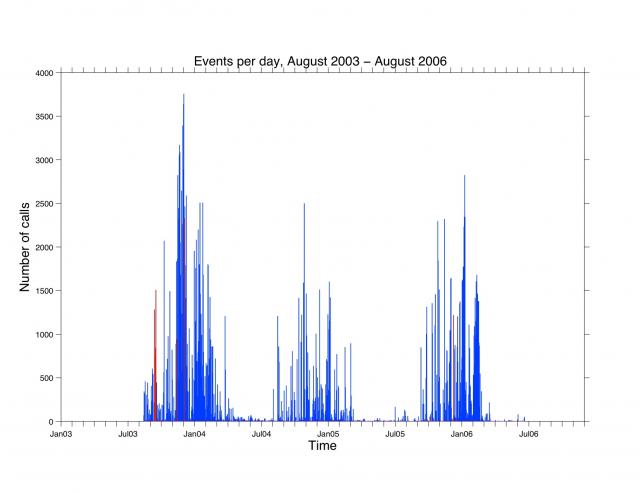SouleD
From 2003-2006, we deployed an eight-station seafloor seismic network along a 10-km portion of the Endeavour segment of the Juan de Fuca ridge. In addition to microearthquakes, the network recorded an extensive data set of 20-Hz fin and blue whale calls. During the first year of operation we have identified more than 100,000 fin calls. The call rates vary seasonally with highest rates from November through January and very few calls from May to August (Soule et al.,2009). Previous work at this site has detected enhanced concentrations of zooplankton throughout the water column above the hydrothermal vent fields compared to sites 10 km away(Burd and Thomson 1995). As part of the project to investigate the hypothesis that whales are preferentially found above the hydrothermal vent fields, we have developed an algorithm to detect and track vocalizing whales that swim near the seismic network. The tracking algorithm can successfully track whales up to 10-15 km from the seismic network with little human intervention. The statistical analysis is focused on understanding the calling patterns and how these could be correlated with known diving patterns that have been linked to feeding (Croll, Acevedo-Gutierrez et al. 2001). For each track we measure the spatial length, total elapsed time, estimated velocity, the distribution of call intervals, and the distribution of call frequencies.
One application of this analysis would be to determine if gaps in calling occur preferentially along the ridge axis. This would help explore the possible trophic link between the mantle and the rest of the food chain because it is believed that whales feeding at depth do not vocalize. Studies have already been published that connect vent biota to zooplankton (Burd and Thomson 1995). This study utilizes data collected as part of a ridge study that expands the broader implications of ridge research while making immediate contributions to marine mammal science. Establishing this link would connect a food chain that encompasses the oldest and smallest microbes on the planet with some of the largest animals to have ever lived.
Integration and synthesis.
My current work is clearly relevant to R2K’s broader objectives, but does not have an obvious fit into the meeting because there is no distinct water column theme. I participated in the Endeavour Tomography Experiment and will soon be attempting to create tomographic images with the seismic data we collected in summer 2009. My interest is in the magma plumbing system of the Endeavour Ridge and the associated hydrothermal vent system. The data set we have will provide insights into mantle flow, the distribution of hot and partially molten rock at mantle and crustal depths, segment-scale variations in crustal thickness, and their associated hydrothermal systems. The thematic groups I have chosen were picked to enhance my understanding of the questions surrounding the crustal structure and other magmatic hydrothermal features that can be imaged using seismic tomography.
Burd, B. J. and R. E. Thomson (1995). "DISTRIBUTION OF ZOOPLANKTON ASSOCIATED WITH THE ENDEAVOR RIDGE HYDROTHERMAL PLUME." Journal of Plankton Research 17(5): 965-997.
Croll, D. A., A. Acevedo-Gutierrez, et al. (2001). "The diving behavior of blue and fin whales: is dive duration shorter than expected based on oxygen stores?" Comparative Biochemistry and Physiology a-Molecular & Integrative Physiology 129(4): 797-809.
Soule, Dax C., Wilcock, William S. D., Thompson, R. E. (2009) " Distribution of fin and blue whales above hydrothermal vent fields on the Juan de Fuca Ridge, N. E. Pacific Ocean" Society for Marine Mammology Poster.

